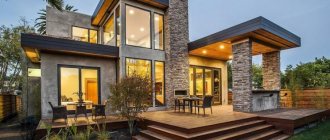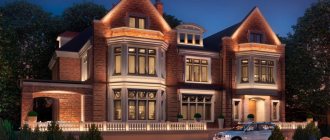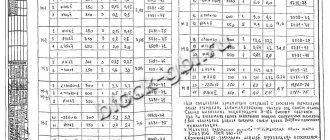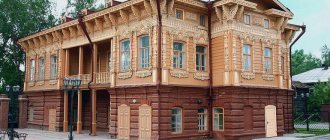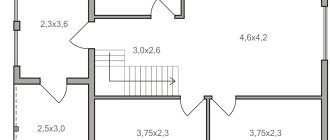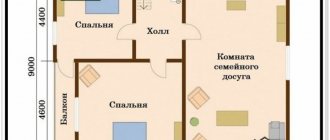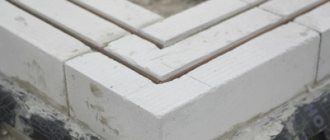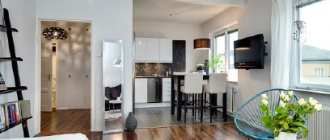Unique projects, experimental nature, bold decisions - all this is about the houses that architects design for themselves and their loved ones. This is the only case when an architect simultaneously acts as a performer and a customer, embodying his most non-standard ideas.
In this material you will learn:
- in which houses famous architects of the 20th century lived and worked;
- how their principles were reflected in the process of designing and implementing their own homes;
- what stories lie behind these projects.
Melnikov's house-workshop
Years of construction: 1927—1929 Place: Moscow, Russia Materials: brick, wood
More a cultural anomaly than an architectural marvel. Konstantin Melnikov, the main dreamer of the Soviet avant-garde, managed to build an experimental three-story residential building for his family during the era of the “housing question.” This project to introduce new architectural forms into practice was supposed to become a prototype of Soviet communal houses.
The building consists of two vertical cylinders embedded into each other. Numerous hexagonal windows ornamentally pierce the facade, a bright, cathedral-like studio on the third floor. The relief inscription “Konstantin Melnikov Architect” is proudly carved above the entrance.
Despite the loan provided by the Moscow City Council for 15 years, Melnikov was severely limited in funds. The house was built in strict economy mode from the cheapest traditional materials: wood and brick. There are no load-bearing structures inside the building, and there are practically no isolated rooms.
From the low ground floor to the high, bright studio and roof terrace, the space of the house seems to expand. The artist’s palette of colors enhances the effect: honey yellow in the bedroom, lilac in the spacious living room, white in the architect’s studio. And even bulky antique furniture looks quite appropriate in these modernist interiors.
How to behave in negotiations with an architect?
Your architect is the person you trust to design your dream home. You will be investing a lot of money not only in the project, but also in the design and materials, and you need to be sure that you can get closer to your ideal.
When you are interviewing various architects for a job, one of the deciding factors should be whether you deliver and whether you are confident enough that you can approach them and everything will work fine.
A breakdown in communication can have a lasting impact on the entire project, so when choosing an architect, make sure you can depend on them and that you are comfortable with them.
"Cabanon" by Le Corbusier
Years built: 1951—1952 Place: Roquebrune-Cap-Martin, France Materials: wood, plywood
Not a house, but rather a hut - the last refuge of the great modernist on the Cote d'Azur of France, where he spent the last years of his life. The small space of 15 m², slightly smaller than a ship's cabin, is an example of an architect's minimal home. Although the appearance of the cabin resembles a traditional log structure, it is carefully designed using a modular system developed by Le Corbusier based on the proportions of the human body.
“Not a single square centimeter was wasted. A small cell in the kingdom of human existence in which every accident was foreseen."
The house, made from prefabricated parts and defiantly modest materials, has everything you need: a workspace, a sitting area, storage cabinets, plumbing and a primitive ventilation system. The walls are decorated with colorful murals and the ceiling is coated with a layer of paint. Built next to a restaurant, the house did not need a kitchen: the door led directly to the dining room.
The only building designed by Le Corbusier exclusively for himself can hardly be called a soulless “machine for living.” Despite the apparent contradiction of some of the principles of the modernist, the hut is ample proof that strict adherence to proportions and attention to light are the keys to perfection in architecture.
Why do we also need a designer and an engineer?
Design work does not end with calculating materials and drawing up a detailed house plan. If the architect has the competence of a designer, he is also a constructive part of the project. But it’s better if these are two separate specialists - after all, these are different types of work.
The structural part of the project is everything related to the construction of the house: masonry plan, layout of slabs, design of the foundation, development of joints, fastening schemes, floor spans. Ideally, an architect develops a house project, after which a designer is involved in the work, who calculates and draws all the technical aspects of the project, calculates the load distribution, and determines the thickness of the load-bearing walls. It is the designer who designs the foundation - based on the calculations that the architect makes when removing the loads. When constructing a house according to the project, all types of loads on all load-bearing structures of the house must be taken into account and correctly distributed.
And finally, the third specialist who can be included in the “ideal” scheme is an engineer who, based on the documentation developed by his two colleagues, supervises the construction and accompanies the project. His functions are not to supervise the workers so that they do not drink and create incidents, but to consistently monitor their work, issue tasks and accept their completion.
Our expert explains:
“The person thinks: “I’ll draw it myself, and let the team build it.” And this can affect durability. The more we invest in a house at the construction stage, the less we will have to invest later during the operation stage. And the costs of the project are not as high as it seems. According to minimal calculations, the costs of the project, design development and supervision are about 2% of the cost of building a house. And there will be more reliability. In addition, architects and designers provide a guarantee for their projects - the market average guarantee is 5 years, but there are also companies that increase this period to 10.
We are talking about geological surveys on the site, which determine the type of soil, possibly the occurrence of groundwater, and the location of geological layers. Photo: spbgeo.ru
Canoa House by Oscar Niemeyer
Year of construction: 1951—1953 Place: Rio de Janeiro, Brazil Materials: reinforced concrete, glass, wood
Oscar Niemeyer, the last classic of modernism and student of Le Corbusier, was the complete opposite of his teacher. Le Corbusier's architecture was based on functionality, ergonomics and technology. Niemeyer's architecture is poetic, sensual, soft. Inspired by Brazilian nature and the curves of the female figure, he softened the severity of the forms with the expression of a flexible line. Niemeyer was the first to show that concrete could be as malleable and plastic as clay.
The architect's own home overlooking the ocean is a classic example of organic architecture and a manifesto of lyrical modernism. The use of materials such as reinforced concrete and glass, plastic forms, a close connection with nature - all these principles together complement each other, creating an individual style in which the whole essence of Oscar Niemeyer's architecture is concentrated.
“Architecture should be functional, but above all beautiful and harmonious”
The curved flat roof, supported by thin steel columns, and transparent glass walls make the building one with its surroundings. The granite block, part of which is located outside and part of which rises in the living room, actually becomes the center of the entire composition. Niemeyer emphasizes that all barriers and boundaries with the outside world are conditional.
The layout of the house also confirms the architect’s break with conventions. Niemeyer skillfully plays with the concepts of “privacy” and “openness.” On the fully glazed ground floor there is a living room and a kitchen. From the top floor, a staircase leads to a closed area where there are bedrooms, bathrooms and the architect's office. Just a small protected shelter in the endless world of nature beyond human control.
Alvar Aalto's Experimental House
Years of construction: 1952—1954 Place: Muuratsalo island, Finland Materials: brick, wood, ceramics
Alvar Aalto's summer house is a kind of laboratory for the architect, his testing ground for conducting experiments. The house is located in a picturesque location on the rocky shore of the lake, covered with coastal forest. It is here that the Finnish modernist finds freedom for architectural experiments with materials, construction techniques and architectural forms.
The house consists of two wings, the smaller of which contains the living room, and the main one contains three bedrooms, a kitchen and a dining room. The main feature of the architectural composition is the courtyard with an equipped place for making a fire. Two high white brick walls, reminiscent of ancient ruins, complete the picture. Together with the wings of the house, these walls surround the courtyard, making the space look like an ancient Roman atrium. Alvar Aalto was inspired by Italian architecture. He liked to say that each of his projects began with a trip to this country.
“Any architectural solution must contain a human motive, born from an analysis of living reality”
In his creative laboratory, Alvar Aalto experimented with materials, foundations and solar heating systems. The architect divided the walls and floor of the courtyard into 50 fragments, differing in the type of bricks, the way they were laid and the presence of ceramic inserts. This allowed Aalto to analyze the durability of materials and their response to harsh climates.
The interior of the house is decorated in a typical Aalto style: white plastered walls, an abundance of wood in the decoration, furniture made of bent plywood, bright contrasting textiles. In addition to the main building, the architectural ensemble also includes a barn, a Finnish bathhouse and a pier for a boat, designed personally by the architect.
Projects of modern country houses with an area of 150-250 sq. m.
We move on to more expensive houses, with an area of 100 square meters. m., which are of interest to the widest range of developers.
A combined house with a residential attic floor and a roof covered with flexible tiles.
House area 180 sq. m. Cost – 4 million rubles. Pay attention to the successful combination of natural wood and stone in the decoration of the cottage.
Modern house with an area of 170 sq. m. for 5.5 million rubles.
Only the green roof stands out from the general color scheme of the walls and base.
Layout of the premises of a house for 5.5 million rubles.
Another combined house - log and stone.
It feels like an architect worked on the project. House area 230 sq. m. Cost – 7.6 million rubles.
Classic house for 4 million rubles. area 145 sq. m.
House built in Karelia.
Notice how well the house fits into the suburban area and landscape design, and all the buildings are in harmony with each other.
A small and very cozy house.
Modern country house in European style with an area of 150 sq. m. m for 4.6 million rubles.
Eames House
Year of construction: 1945—1949 Place: Los Angeles, California, USA Materials: glass, steel, concrete, aluminum, wood
The home of designer couple Charles and Ray Eames in the suburbs of Los Angeles was designed as part of a program to build experimental housing. The architects who participated in this program used the latest materials and technologies developed during World War II in their projects. The houses had to demonstrate a modern style and be simple to build. The Eameses' house, originally built as a competition showpiece, later became their own.
The building sits on a hillside and is supported by a massive concrete retaining wall. The building itself consists of two glass rectangular blocks, one of which houses a studio-workshop, and the other - living quarters. The steel frames are filled with rectangular inserts of various colors and sizes - panels made of glass, aluminum and asbestos. The Eames house seems like a living embodiment of the abstract paintings of Piet Mondrian.
The interior is replete with assorted furniture made from natural materials and numerous decorative items. There is no clear division of space. The abundance of wood, soft diffused light penetrating through multi-colored panels, and some creative randomness - all this creates a special, very personal atmosphere.
Walter Gropius House
Years built: 1937—1938 Place: Lincoln, Massachusetts, USA Materials: stone, brick, wood, glass block, steel, plastic
Walter Gropius, one of the most influential architects of the 20th century and founder of the Bauhaus school, emigrated to the United States in the 1930s and began teaching at Harvard University. At the same time, he built his house, which is a hybrid of traditional New England architecture and the modernist teachings of the architect. Gropius shows that mass-produced American objects can be used quite successfully in modern design. This new architecture incorporates local traditions without sacrificing modernism.
The building has a strict rectangular shape and a flat roof. Long ribbon windows stand out against the white wood paneling. The foundation is made of natural stone. The only exterior decorations are a porch with a wall of glass blocks and a metal spiral staircase - a separate entrance to the room of the architect's daughter.
The space on the first floor is divided into zones using transparent glass panels. Almost all the furniture was made in the Bauhaus workshops in Dessau. This is the school's largest collection of furniture outside of Europe. The interior is based on personal belongings taken by Gropius from Nazi Germany. For the interior decoration, the architect uses a minimalist color palette consisting primarily of black, white, pale gray and earth tones.
When designing the house, special attention was paid to the latest technologies for that time. Gropius thought over a natural ventilation system and installed acoustic soundproofing panels made of plastic. The farm used rainwater, which was collected thanks to special inclined planes of the roof.
Large country houses made according to individual projects
Let's move on to modern house designs with an area of more than 200 square meters. m and a price of 10 million rubles. First example.
Second example, for 16.5. million rubles, stylized as a castle.
Both houses are located on large plots. Don’t try to “shove” a house of 200-300 square meters onto a plot of 7-10 acres. The building will “eat up” most of the territory and will look awkward.
Another successful combination of wood and stone.
Layout of premises.
A house with a flat usable roof, on which you can install engineering equipment and equip an observation deck and, expensive, but not flashy finishing.
This is a barn style house in the Moscow region.
The house has large panoramic windows. Wall decoration - natural wood.
A house in the “Barn house” style is not for everyone, but you must agree that such cottages look advantageous and unusual against the backdrop of the kingdom of houses made of “red” brick, siding, metal tiles and corrugated fences.
The Glass House by Philip Johnson
Years built: 1948—1949 Location: New Canaan, Connecticut, USA Materials: glass, steel, brick
Inspired by Ludwig Mies van der Rohe's Villa Farnsworth, Philip Johnson begins his first large-scale project, following the German architect's principle of "Less is more." The small, single-story, open-plan house is conceived as a simple rectangular structure made of glass and steel.
The interior space of the house consists of one room, divided into zones by low wooden modules. The only closed room demarcating the space from floor to ceiling was the cylindrical brick bathroom. The number of pieces of furniture has been reduced to a strict minimum.
“This thing is the purest thing I have created in my life in architecture.”
The relationship between interior and exterior played a key role for the American modernist. The glass house was not just an architectural object, but part of a carefully thought out landscape project. Johnson viewed the landscape as a visual extension of the interior of the house. Like furniture, it was an integral part of the interior. He himself liked to say: “I have very expensive wallpaper.”
The Glass House was the first of 14 structures that Philip Johnson erected on his property in Connecticut during his fifty years of creative activity. The architectural complex also includes a guest house, art galleries and pavilions.
Small country house projects
Houses up to 100 sq.m. m, are traditionally in demand among developers who are looking for inexpensive homes or country houses. Then you will like the completed projects below.
One-story house with an area of 100 square meters. m, which harmoniously fit into the suburban area and became part of it.
The cost of the house is 1.65 million rubles.
A house with a simple gable roof, stylized as Finnish designs for one-story buildings.
Please note that the decoration of the walls of the house visually imitates the trunks of pine trees that grow on the site.
Dimon2012FORUMHOUSE Member
Here is another cute house with an area of 84 square meters. m. The house looks beautiful. Properly integrated into the site and stylishly finished.
Another Finnish project near St. Petersburg is a house with an attic floor, a gable roof covered with flexible tiles and large windows. The color of the house successfully echoes the surrounding pine trees.
House area 120 sq. m, although on the site it looks smaller. Cost – 3.6 million rubles. Notice the large porch that flows smoothly into the terrace.
The house is a godsend for a summer residence.
The monochrome facade is painted in soothing colors. The façade of the house is highlighted by panoramic glazing with wide window lintels painted in contrasting white. A wide terrace has been built around the house, which visually increases and complements the volume of the building.
House Schröder in Utrecht
Years built: 1923—1924 Place: Utrecht, Netherlands Materials: reinforced concrete, steel, brick, wood
Gerrit Rietveld, the most famous Dutch architect and designer of the 20th century, at the request of his widow and later his actual wife, Truce Schröder, designed a house in Utrecht. The recently widowed mother of three wanted a home that perfectly matched her idea of an ideal home. She dreamed of a space that would not limit her.
The house was designed in accordance with the principles of neo-plasticism and the Dutch art association "De Stijl", of which Rietveld was a member. Characteristic features of this direction: the desire for universality, strict geometry of forms, artistic purity and rigor. The house looks like an orderly system of black, gray, white, blue, red and yellow elements. The building does not serve as a background for an abstract composition, but is itself one.
The frame of the house is made of reinforced concrete slabs and steel profiles, the walls are made of brick. The first floor has a completely traditional layout - the kitchen, studio and library are separated by walls. The second floor is a space that can be easily transformed using sliding panels. Instead of curtains, colored plywood shutters were used. According to the principles of neoplasticism, interior items were painted in the colors of the main palette. All the furniture in the house was made by Gerrit Rietveld himself.
Country house stylized as a Japanese cottage
There are developers who dream of a house made in Japanese style. Many do not dare to experiment and limit themselves to small architectural forms similar to Japan. For example, they build gazebos with clearly recognizable curved roofs, like a pagoda.
Here is an example of successful stylization in the oriental style. Not ideal of course, but the house looks very harmonious.
And this is a more successful version of Japanese stylization, made according to an individual project.
Vanna Venturi House
Years built: 1962—1964 Place: Philadelphia, Pennsylvania, USA Materials: brick, wood
In the 60s of the twentieth century, aspiring architect Robert Venturi designs the first “anti-modernist” building in history for his mother. Two years after completion, Venturi published a manifesto, “Complexity and Contradiction in Architecture,” in which he criticized modernism and the International Style. Soon this work would mark the beginning of the postmodern movement, despite the fact that Venturi himself never considered himself a postmodernist.
Behind the external simplicity of the façade lies a complex and contradictory architectural concept. Instead of the already familiar asymmetry, there is almost complete symmetry, broken only by the location of the windows. A gable roof, a pediment “split” into two parts, and a massive chimney, atypical for the architecture of that time - each detail is a kind of protest against modernism. From the outside it may seem that the house is much larger than it actually is - Venturi deliberately distorts the scale.
Violations of proportions are also present in the interior of the house. The size of the fireplace does not correspond to the size of the room, and wide, low doors and windows of different sizes further enhance this visual effect. At the request of the architect's mother, all main living spaces are located on the ground floor. The entire second floor with a spacious studio bedroom and a terrace was occupied by Robert Venturi himself.
Venturi shows that the desire for a polysemantic architecture, with all its attendant contradictions, does not mean a renunciation of functionality and integrity. To Ludwig Mies van der Rohe’s famous phrase “Less is more,” Venturi wittily replies: “If less, then sadder.”
Isn't it better to save on the project and not hire an architect?
It is no secret that many future homeowners do not want to order a separate project and hire an architect - it is a shame to spend money on this. After all, formally drawing up an architectural design for a house is now not required by law.
However, in such considerations of economy there may be a fundamental mistake: a well-designed house design will provide approximately 98% of the material consumption of the house. The architect and designer will outline most of the details: what brand of lintels will be, what floor slabs will be, how much materials will be needed - for example, the cubic capacity of brick or the number of tons of cement. Thus, after working with a professional and competent architect, there will be no excess building materials left on the site, because the specialist operates with clear numbers.
Igor Suslov says:
— Have you perhaps noticed in areas where construction has just been completed, mountains of boards, stacks of bricks, bags of cement? On Avito, sometimes you also come across advertisements in the spirit of “I will sell leftover materials from construction.” At the same time, you need to understand that excess materials mean extra money spent by the customer. In our experience, the average loss of materials from construction using “homemade projects” is 150-200 thousand rubles. At the same time, the average cost of a house project starts from 400 rubles per square meter. That is, even if you pay 40,000 rubles for the project of a 100-meter house, you will save about 100 thousand on the calculation of materials.
So how do savings come about with proper design? This happens because the architect proceeds from the modularity of materials: standard width and height of bricks, volume of gas or foam concrete blocks, standard sizes of floor slabs or standard length of wooden beams. In a word, each material has its own geometric standards, so you need to design your house and premises in such a way that you need to change these standards (for example, saw them off) as little as possible. Proper calculation ensures that a minimum of residues are formed, and therefore money will be saved. The entire list of materials that will need to be used for construction will be attached by the designers to the project.
Proper calculation ensures that a minimum of residues are formed, and therefore money will be saved. Photo: au.ru
Igor Suslov gives an example:
— Lately we have seen a lot of projects in which there are many monolithic floor sections. But such plots are an expensive pleasure. And we see that the architect makes a non-standard calculation, which will have to be implemented at the expense of the customer’s wallet. But all this can be calculated taking into account the standard sizes of the material, because each of them has its own modularity.
